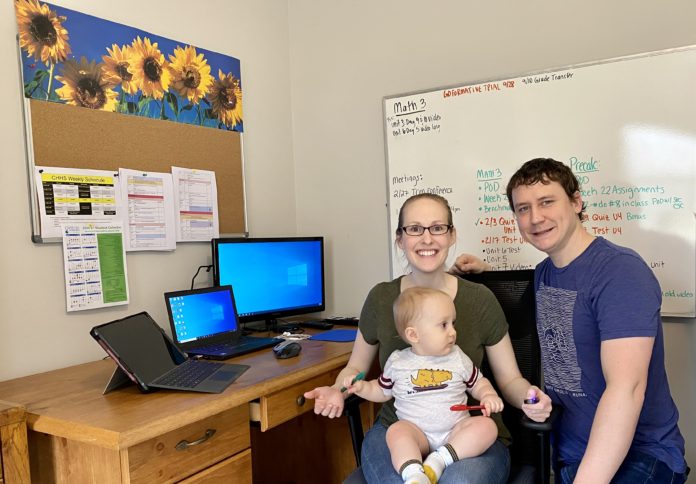
In August, when Chapel Hill-Carrboro City schools began operations remotely, teachers scrambled to transform extra spaces in their homes into offices where they could conduct lessons over Google Meets. While, on camera, these makeshift classrooms may appear immune to interference, for some Chapel Hill High School teachers, children sometimes break that barrier.
Take, for instance, English teacher William Schrader, who—during an important meeting with faculty—was surprised to find his three-year-old daughter attempting to pick the lock of the door to the room where he teaches. Last spring, he taught remotely in his garage, where he had to block out the noise of his kids coming in and out, often to take their bikes for a ride. And while the lighthearted innocence of these distractions can be amusing, on a particularly frustrating day, interruptions like these can also prove somewhat irritating.

“Whenever [my daughter] sees me at my computer, she orders me to print My Little Pony coloring pages,” Schrader said. “She likes to scroll through and pick each one out individually; it’s a very involved process. And I am fine with that: she loves it. But sometimes, when I’m trying to get work done and she’s sitting on my lap looking at pictures of Rainbow Dash, it can be distracting.”
The interruptions of family members may serve as disturbances not only to instructors, but also to students, whose lessons may be brought to a grinding halt or whose concentration may be taken off classwork.
“One day in class, my teacher’s kid began screaming for several minutes, which didn’t necessarily inhibit my learning experience but was definitely a bit annoying,” Chapel Hill junior Lola Oliverio said. “Mostly everyone in the call just laughed it off, but, I mean, the sound was pretty grating—especially because I was trying to get work done.”
Not every teacher, though, tries make their classroom childproof.
CTE instructor Kevin Schoden said his two daughters, Emerson and Nolyn, regularly interact with his students.
“They come in all the time, especially Nolyn, and ask my class how their day is and if they need any help,” Schoden said. “Emerson snuck in once and told everyone it was my birthday and had everyone sing to me. They interact with the [students] all the time.”
Teachers point out that the increased time they now spend with their children and partners has also strengthened family bonds and created memories to be cherished in the future.
“In between classes, I can hang out with [my children] a bit; we’ve been going into a nearby forest to have picnic lunches a lot,” Schrader said. “I definitely feel more connected to my children and that I know them better than I ever have before.”
The introduction of hour-long asynchronous work periods to Chapel Hill High’s daily schedule has given faculty and students more freedom during their workdays. Teachers can use the time for work-related matters like attending meetings, grading assignments or planning, or they can spend time with loved ones, taking walks, talking or eating lunch together.
“There are days when I focus entirely on school work, and there are pockets of most days when I’m checking in on my kids, their assignments, getting them outside for a bit,” math teacher Blake Norris said. “Because the school schedule isn’t as ‘full’ as a face-to-face schedule, there’s more time for both work and family time, so I try to manage both as best I can.”
Every teacher’s household situation, of course, varies. Math teacher Susan Thorne, who has a one-year-old child, lets her son Levi stay downstairs, where he is watched by in-laws and is allowed to play and learn without distracting his parents’ work.
English teacher Brian Wasson sends his two-year-old son to daycare and has a multi-story house that allows for him and his wife to work in separate rooms.
“I don’t have much stress,” Wasson said. “My wife works at home, so you would think that might be an issue. However, my wife and I work well together, and we know how not to get on each other’s nerves.”











